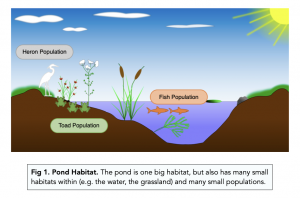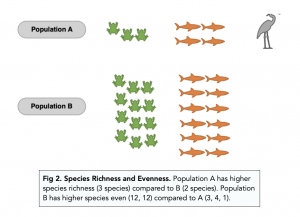Introducing Biodiversity (A-level Biology)
Introducing Biodiversity
Biodiversity
Biodiversity is a measure of the variety of living organisms within a particular habitat, ecosystem, biome, or all over Earth.
A habitat is an area where one or more organisms live. For example, a fish could have a pond as its habitat. Some other habitats are sand dunes, woodlands, meadows and streams.
A community refers to all of the populations present inside a single habitat. For example, a pond might have populations of birds, toads, fish and insects.
Endemism is when a species is only found in a particular place. These species are unique to their area and will not be found anywhere else.

Levels of Biodiversity
There are different levels of biodiversity:
- Species diversity: the number of different species within an area.
- Habitat diversity: the number of different habitats within an area.
- Intra-specific genetic diversity: the diversity in genes within a species.
- Inter-specific genetic diversity: the diversity in genes between species.
Species Richness and Evenness
Species Richness
Species richness is the number of species within a particular region or habitat.
Species richness only measures the number of different species, but not the number of individuals in each species. Therefore, a species with only 10 individuals is counted equally as a species with 100 individuals.
We can measure species richness through a technique called random sampling. This involves counting the number of different species in random samples of a habitat.
Species Evenness
Species evenness takes into account the number of individuals in each species.
Using species evenness, we can develop a distribution of all the species in a region, as well as how equal their populations are:
- If all species have similar numbers of individuals, then species evenness is considered to be high.
- If all the species have varying numbers of individuals, then species evenness is considered to be low.
Again, we can measure species evenness through the technique of random sampling. Instead of the number of different species that are found in random samples of a habitat, we have to look at the number of individuals of each of these species.

Biodiversity refers to the variety of life on Earth, including the variety of species, ecosystems, and genetic differences within species. It is the result of billions of years of evolution and is essential for maintaining the health and stability of ecosystems.
Biodiversity is important in Biology for several reasons. It helps to maintain the stability and health of ecosystems, as each species plays a unique role in the ecosystem. Biodiversity also provides us with a wide range of resources, such as food, medicine, and raw materials, and it helps to regulate the Earth’s climate.
Biodiversity affects ecosystems by providing stability and resilience. When an ecosystem has a high level of biodiversity, it can respond better to changes, such as changes in the climate or the introduction of a new species. Biodiversity also ensures that all the necessary functions, such as pollination and nutrient cycling, are carried out effectively.
There are three main types of biodiversity: species diversity, ecosystem diversity, and genetic diversity. Species diversity refers to the variety of species within an ecosystem, ecosystem diversity refers to the variety of ecosystems, and genetic diversity refers to the variety of genetic material within species.
The causes of biodiversity loss include human activities, such as deforestation, pollution, overfishing, and climate change. These activities result in the destruction of habitats, the introduction of non-native species, and the alteration of ecosystems. Natural causes, such as volcanic eruptions, earthquakes, and meteor impacts, can also lead to biodiversity loss.
Biodiversity loss can be prevented through a combination of conservation efforts and sustainable development practices. This includes the protection of natural habitats, the restoration of degraded ecosystems, and the reduction of human activities that harm the environment. Additionally, it is important to promote sustainable development practices, such as sustainable agriculture, renewable energy, and the reduction of waste.
Conservation is a critical component of protecting biodiversity. It involves the protection and management of habitats and ecosystems, as well as the preservation of endangered species. This can be achieved through a variety of measures, such as the creation of protected areas, the restoration of degraded habitats, and the introduction of sustainable development practices.
Individuals can contribute to the conservation of biodiversity by making simple changes to their daily lives, such as reducing waste, conserving energy, and using sustainable products. They can also support conservation organizations and advocate for environmental protection. Additionally, individuals can help to protect biodiversity by participating in conservation projects, such as planting trees, monitoring wildlife, and removing invasive species.
Some examples of endangered species include the African Elephant, the Bengal Tiger, the Blue Whale, the Giant Panda, and the Leatherback Turtle. These species are at risk due to a variety of factors, including habitat loss, poaching, hunting, and climate change.
Studying biodiversity as part of A-level Biology is important because it provides students with a deeper understanding of the variety of life on Earth.






Still got a question? Leave a comment
Leave a comment